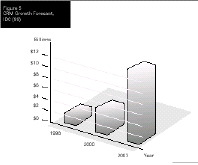|
|
 |
|
 The
CRM Market The
CRM Market
|
|
 |
|
|
CRM is hot and getting
hotter. Many believe that CRM will surpass ERP and will become
one of the largest application segments ever. This phenomenon
is not only a new application area but will eventually change
the business models of the enterprise. As products become commodities,
and all other things being equal, the added value provided by
Customer Relationship Management will determine the success
or failure of one player over another.
One need just look around and count not only the players but
look into their line of business. CRM is flooded with vendors
from all areas. Traditional vendor categories no longer fit
and the accepted boundaries between hardware, software, and
service vendors are blurred. The wide variance of players in
the hyped CRM market is unprecedented.
ERP vendors such as Oracle, PeopleSoft, and SAP are attempting
to expand their business as saturation is reached in the back-office
market. A shift is seen to include frontoffice applications
among the ERP vendors who are leveraging on their size, installed
base, and promise of integration. Although the CRM applications
require a different skill set, analysts predict a very significant
market share for these vendors over the next few years. |
|
|
 The
hardware, infrastructure, and CTI companies such as Cisco,
HP, IBM, Lucent, Nortell, Geneysis, and Quintus are realizing
the opportunity of the CRM trend. These businesses are expanding
to include the necessary software in order to provide CRM
offerings. System Integrators (e.g. KPMG, E &Y) are offering
their services and quickly enhancing their expertise to service
the integration needs of a complex CRM adoption.Analysts claim
that integration costs are anywhere from 2 to 10 times the
software cost, which is keeping SIs very busy. |
| In addition, software
companies that have a software package that even remotely can
be considered a component of a CRM suite are renaming their
product CRM and are positioning their business as such. Old
call centers and customer service applications are being revived
and repositioned to also jump on the CRM bandwagon. Last, but
not least, even the giants such as Microsoft and Compaq are
declaring their CRM strategy and tying it into their other lines
of business. |
|
|
| Looking at the number
of mergers and acquisitions and at who the players are, indicates
the opportunity and desire of so many in this area to have part
of the promising and lucrative CRM pie. It is interesting to
note the crossing of traditional business boundaries in so many
of the recent mergers and acquisitions. |
 |
Here are just some examples of the
M&A activity in the CRM arket to illustrate this point:
Siebel & IBM; Peoplesoft & Vantive; Nortell &Clarify;
HP & Oracle. The consolidation that is taking place is only
the tip of the iceberg when it comes to assessing the potential
value in this dynamic market place. The chart below, figure
5, shows the CRM growth forecast according to IDC. |
|
|
| Conclusion |
The popularity of CRM
is fed by the fact that better customer relationship management
is advantageous for both the customer and the enterprise. The
end-user clearly enjoys great advantage from increased CRM.
Better service
is not only pleasant but has tremendous value in its own right.
The total value of a product with customer service is significantly
higher than of the product alone. |
|
|
|
| On the other hand, the
enterprise implementing CRM is not doing it for altruistic reasons.
Companies have come to realize that their customers are their
real asset. The benefits when CRM is adopted are very significant.
Industry statistics show that 68% of customers who walk away
from a relationship with a vendor do so because of poor customer
service. Statistics also show that 80% of a companys income
is from its repeat customers. |
|
| A company that has both
customer knowledge and the applications to leverage this information,
has the advantages to: |
Increase customer retention
by enhancing satisfaction as a result of higher responsiveness.
Identify the most profitable customers and treat them accordingly.
(20-80 rule).
Reduce marketing costs by developing effective targeted campaigns.
Direct qualified leads to appropriate sales channel.
Increase sales by offering the correct products (cross-sell/up-sell).
Achieve higher ROI by increasing profits per sale.
Streamline the sales cycle managed by interdepartmental workflow.
Eliminate redundant functions by centralizing common activities.
Save costs by reducing errors that occur from multiple uncoordinated
interaction points.
Improve understanding of customer needs by using their preferred
channel of communication.
Leverage on previous contacts with other customers for the
current interaction.
Estimate future sales, marketing, and service activities based
on analysis of past performance. |
| For CRM to have a significant
impact on the organization, enterprise-wide communication and
commitment are required. There is no question that to stay competitive,
businesses must invest in CRM technology as well as in a new
business model. It is the pooling of all customer information
that is the core of a successful CRM implementation. This powerful
strategy will increase sales, customer loyalty, and competitive
advantage. |
|
|
|
|
|
|
|
|
|
|